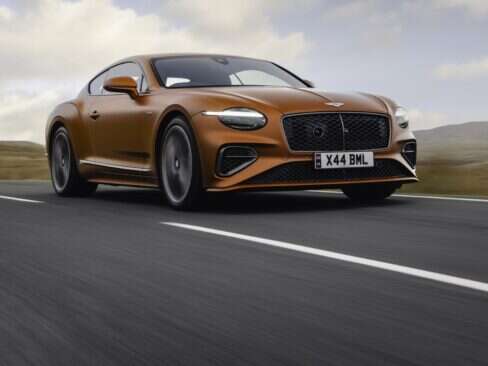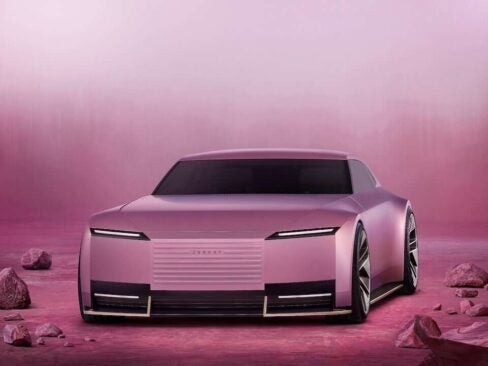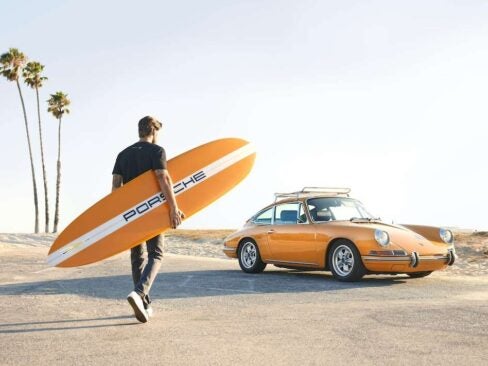
Believe it or not, the first Lamborghini was a tractor. The company’s founder, Ferruccio Lamborghini, was born into a winemaking family in Cento, northern Italy, and after serving as an air force mechanic during World War II, began building tractors from surplus military machinery.
Ten years later, his tractor company, Lamborghini Trattori S.p.A, was one of the biggest farm equipment producers in Italy, and business was booming at his air conditioning and gas heater firm. Not the glamorous origins you might expect.
The success of these businesses allowed Ferruccio to indulge his lifelong love of fast cars, and his garage overflowed with Alfa Romeos, Lancias and Maseratis. He bought his first Ferrari, a 250GT, in 1958—the first of many—though at heart he felt Ferrari was too noisy and rough to be a true road car. He believed Ferrari was a track car repurposed for the road.
On one fateful day in the early 60s, the clutch on Ferruccio’s Ferrari broke. Inspecting the damage, he discovered the clutch was the same he used on his tractors, so he asked Ferrari for a superior replacement. Ferrari laughed Ferruccio out the door, claiming his knowledge of tractors hardly made him an expert on sports cars. So Ferruccio set out to prove them wrong, launching his own car manufacturer to rival Ferrari. The name: Automobili Ferruccio Lamborghini S.p.A. The vision: a grand tourer for the road, not the track.
The first Lamborghinis were launched in the mid-60s to wide acclaim. The 1966 Lamborghini Miura sports coupé was lauded for its power and comfort, and the rear mid-engine, rear wheel drive soon became the norm for high-performance cars of the period. Hard times hit the company after the 1973 oil crisis and economic downturn, with three ownership changes in five years. The firm went bankrupt in 1978 and lay dormant until Chrysler Corporation came to the rescue ten years later. The rescue attempt was short-lived, however, and it took several ownership changes before Lamborghini began seeing success in the 2000s under Audi.
While Ferrari has its prancing horse, Lamborghini has its raging bull. A Taurus himself, Ferruccio was inspired by a trip to his friend’s farm in Spain in 1963. The friend, Don Eduardo Miura, was a renowned breeder of fighting bulls, and lent his name one of Lamborghini’s most successful cars. Later models looked to the bullfighting world for their nomenclature—Islero was the bull that killed legendary bullfighter Manolete in 1947, and Espada is the Spanish word for the matador’s sword. The later Lamborghini Countach has nothing to do with bulls directly—‘countach’ is a word Italian men use when an attractive woman walks by.
So with all this hoof-stomping and catcalling, just how fast do these machines go?
Lamborghini Diablo Coatl

Top speed: 239 mph
0-60 mph: 3.54 seconds
A reworking of the original Diablo, the Lamborghini Diablo Coatl was built in Mexico by Automoviles Lamborghini Latinoamérica S.A., a company launched in 1995 to build and distribute Lamborghinis in Latin America.
The Coatl is a race oriented model built in a limited run, based on the specifications of private buyers. An entirely bespoke car, the steering wheel was carved by a single craftsman based on the hand and finger measurements of the buyer. The seat was based on a mould taken from the buyer, with body weight taken into account and pedal positions adapted according to the driver’s height. Even the exterior and interior color was designed according to the buyer’s preferences.
The first Lamborghini Diablo Coatl took four years in the designing and building, and was launched in 2000 under the name Lamborghini Eros 2000. With a new power output of 635 bhp, the displacement was enlarged to 6.3 liters and the chassis was modified to cope with the power hike. The new Chromium Molybdenum steel chassis was designed in England by McClaren. The bodywork consisted of carbon fiber and Epoxica by Aereo-Astonautico. The entire front part comprised a single unit with built-in air extractors akin to those on the Ferrari F50. The deep chin spoiler had twin air intakes to cool down the front brakes, while the side featured two further air intakes, with vertical slats feeding air to both the engine and the rear brakes.
Lamborghini Gallardo Dallas Performance Stage 3

Top speed: 233 mph
0-60 mph: 2.8 seconds
Texas-based tuning experts Dallas Performance upgraded the Lamborghini Gallardo from 520 hp to 650 hp, by adding a twin turbo setup among other modifications.
The first stage increased the Gallardo to 650 whp with 93 Octane Fuel and 800+ whp with E85 or VP C16 Race Fuel with the added turbochargers. The second stage brought back the turbochargers, but added forged engine internals for a total of 800+ whp with 93 Octane Fuel or 1050+ whp with E85 or VP C16 Race Fuel. stage three brings the highly modified engine up to 1000 whp with 93 Octane or 1200+ whp with E85 or VP C16 Race Fuel, while stage 3R replaces the standard V10 with a race-spec engine for a total of 1000 whp with 93 Octane or 1400+ whp with VP C16 Race Fuel.
The engine upgrades cost somewhere between $35,000 and $95,000, and that’s before additional accessories such as the high flow sport exhaust system, cat delete pipes, high flow air inlet system, ECU custom mapping/dyno tuning, and an E85 fuel conversion (including mapping) which adds 40whp.
Lamborghini Murcielago LP750 Edo Competition

Top speed: 227 mph
0-60 mph: 3.1 seconds
Delivering 560kW of power, the Lamborghini Murcielago LP750 Edo Competition was a development of the original Lamborghini Murcielago supercar.
German tuning company Edo Competition oversaw the tuning, creating a car that can sprint from 0-200km/h in just 9.7 seconds. Edo Competition made a number of mechanical revisions including new cylinder heads, hand-made inlet manifold, new air intake system and intake ducts, a remapped ECU and a high-flow exhaust system. Add to this high performance exhaust headers and catalytic converters, more aggressive camshafts, bucket tappets, mufflers and exhaust tips, and you’ll see why the new car packs such a punch.
On the cosmetic side, Edo Competition added a sharper front lip spoiler to the front of the big Lambo, a newly-designed adjustable rear wing on the back, and finished it all off with angry matte black paint with green highlights.
Lamborghini Murcielago LP710-2 Edo Competition

Top speed: 224 mph
0-60 mph: 3.2 seconds
Edo Competition turned their tuning skills to the Lamborghini Murcielago LP 640 to produce the extraordinary Lamborghini Murcielago LP710-2.
The 6.5-liter V12 engine produces 710 hp (522 kW) at 7625 rpm, with a torque of 700 Nm (516 ft-lb) at 6400 rpm. The result is an acceleration of 0-124 mph in under ten seconds.
The increase in power is thanks to new exhaust headers, high flow catalytic converters, mufflers, exhaust tip, performance camshafts, modified cylinder heads and new high flow air filters. The engine controls were reprogrammed to make the best of individual modifications. The optimized aerodynamics—including an adjustable lip on the rear wing—enhances the stability of the car and only adds to the elegance.
The 4-wheel drive setup of the original Lamborghini Murcielago LP 640 was converted into 2-wheel drive, with an 88 lb weight saving as a result. The high-speed wheel and tire combination consists of a 19-inch light alloy wheel set with special Continental high-speed tires: 225/35 ZR 19 Continental V-max in the front and 325/30 ZR 19 Continental V-max in the rear.
Lamborghini Aventador LP900-4 Molto Veloce DMC

Top speed: 224 mph
0-60 mph: 2.5 seconds
German performance car tuner DMC reworked the Lamborghini Aventador LP-700 to produce the Aventador LP900-4 Molto Veloce DMC.
The 900 in the name refers to the horsepower, which leapt from 691 hp to 885 hp. The magma-inspired paint job is offset by carbon fiber aero add-ons such as a large rear wing spoiler, intake ducts, side skirts, a front splitter and rear diffuser. DMC replaced the entire exhaust system with custom titanium piping, reducing the stock system’s weight by 90%. The LP900 performance kit sees the stock V12’s overhead throttle valves per cylinder bank replaced with 12 unique single intake throttle plates, one for each cylinder. Other features include new pumps and lines and a reprogrammed ECU, and the new wheels come with matte black rims and spokes in the same magma color as the rest of the body.
Lamborghini Diablo VTTT

Top speed: 222 mph
0-60 mph: 3.2 seconds
An extremely rare breed, this modification of the Diablo VT was produced in a limited run of six cars.
The VTTT (viscous traction twin turbo) was offered as a special dealer upgrade by Platinum Motors, the Lamborghini dealership in southern California. The modified cars featured water-cooled, twin blueprinted Garrett T4 turbochargers with custom-built intercoolers, electronically controlled wastegates, cylinder heads with polished ports, competition-type valves with race-type guides and a reprogrammed electronic fuel injection system.
A new short ratio gearbox improved acceleration and a custom Kevlar twin-plate clutch was installed to cope with the extra torque. The brakes were upgraded with cross-drilled, ventilated discs and carbon fiber brake pads. A dash-mounted switch offered three engine settings including a limited valet mode and two levels of turbocharger boost at 6 psi (0.41 bar) and 9 psi (0.62 bar). Such extensive modifications came at a cost—the Lamborghini Diablo VTTT would set you back around half a million dollars, almost twice the price of the VT.
Lamborghini Reventón
 Top speed: 221 mph
Top speed: 221 mph
0-60 mph: 3.4 seconds
Launched at the 2007 Frankfurt Motor Show, the Lamborghini Reventón is the most expensive Lamborghini road car to date, costing a cool two million dollars.
Its top speed was recorded in Dubai at 221 mph (356 km/hour). Only 20 vehicles were sold to the public, with one additional car (marked 0/20) produced for the Lamborghini Museum. The new exterior was based on high velocity aircraft, while all the mechanical elements (including the engine) were sourced directly from the Murciélago LP640.
The Reventón’s namesake was a famous Spanish fighting bull, raised by the Don Heriberto Rodríguez family. The bull gained notoriety in Spain for killing famed Mexican bullfighter Félix Guzmán in 1943. Reventón means ‘small explosion’ or ‘burst’ in Spanish, or more colloquially a large party or big night out.
Lamborghini Aventador LP700-4 Mansory

Top speed: 220 mph
0-60 mph: 2.8 seconds
Unveiled at the 2012 Geneva Motor Show, the 12-cylinder Lamborghini Aventador LP700-4 super-sports car is a customisation project by German tuners Mansory.
The newly designed front body features an apron with bigger air inlets for improved ventilation of the front coolers, as well as combined front lip and daytime driving lights, new front wings and newly designed bonnet.
The side width increases by 40 millimeters on the front axle and 50 millimeters on the rear, while contact pressure at the rear axle is produced by the diffuser integrated into the new rear apron and rear wing. The side sill sets are new, the ultralight forged rims feature carbon fiber inlays and the roof and engine compartment covers have been replaced with carbon fiber. The optimised engine-management system and high performance exhaust system have increased acceleration and engine power: 754hp at 8,300rpm and 750Nm at 6,000rpm. The interior features carbon fiber components, treated leather seats and dashboard, a newly designed airbag sports steering wheel and non-slip aluminium pedals.
Lamborghini Aventador LP700-4

Top speed: 217 mph
0-60 mph: 2.9 seconds
This two-door, two-seater Lamborghini was publicly launched in 2011 at the Geneva Motor Show February 2011, five months after a preview in Sant’Agata Bolognese.
The Aventador was designed to replace the ten-year-old Murciélago as the new flagship Lamborghini. Before official launch, Lamborghini had already sold over 12 months of the production vehicles, with prices around the $380,000 mark in the US. Production was limited to 4,000 units, with eight molds used to make the carbon-fiber monocoque lasting 500 units each. The first 1,000 Aventadors took 15 months to build.
The Aventador uses Formula One-style suspension and a lightweight carbon fiber monocoque. Aesthetically, the Aventador is an evolution of the Murciélago, with a shape that also borrows heavily from Lamborghini’s limited-edition Reventón and the Estoque concept car. The Aventador LP 700–4 uses Lamborghini’s new 700 PS (510 kW; 690 bhp) 6.5 liter 60° V12 engine. Lamborghini’s fourth in-house engine, the engine is second V12 from the marquee and the first all-new V12 since the 3.5-liter powerplant used in the Miura. Honoring the original bullfighting branding, Lamborghini named the car Aventador after a legendary Spanish fighting bull.
Lamborghini Diablo GTR

Top speed: 217 mph
0-60 mph: 3.5 seconds
Meaning ‘devil’ in Spanish, the mid-engined Diablo was built between 1990 and 2001, remains an iconic sports car.
This was the first Lamborghini capable of nudging the speedometer over 200 mph (320 km/h). At the end of its production run in 2001, the Diablo was replaced by the Murciélago. In 1999, Lamborghini introduced the Diablo GT, a refined version of the original Diablo, and the GTR followed in 2000. The GTR used the same basic 6-liter V12 engine as the street-legal GT, but with refined fuel and ignition systems, a lightened crankshaft, individual throttle bodies, variable valve timing, a dynamic air intake duct system and titanium connecting rods.
The GTR offered increased power, stripped interior and reduction in weight, with the air conditioning, stereo, and sound and heat proofing removed to keep the weight at a minimum. The race-ready car featured a single racing seat with six-point seatbelt harness, MOMO fire suppression system and steering wheel, integrated roll cage, fresh air intake and fixed Plexiglass windows with sliding sections. The GTR developed the radical race design of the GT, with a large rear spoiler bolted directly to the chassis, 18-inch hollow magnesium Speedline centerlock wheels, pneumatic air jacks for raising the car in the pit lane and an emergency fuel shutoff switch on the left front fender.
Lamborghini Diablo GT1

Top speed: 217 mph
0-60 mph: 3 seconds
In 1998, Lamborghini dealer Ronald Affolteris customized the Diablo GT to create the GT1.
Every body panel was modified or replaced, including new front and rear fenders. Fixed headlights replaced the GT’s pop-ups, side intakes were enlarged, a custom wing added and twin-ducts installed to feed air to the engine. The twin-turbo V12 engine delivers 630 hp with 5-Speed manual transmission and a mid-engine location. With four small turbos, Lamborghini Diablo GT1 produces the same power as the McLaren F1, but built at half the cost. The open top edition came later in the form of the Evolution GT1 Roadster.
Developed by SAT (Signes Advanced Technology) in France, the Lamborghini Diablo GT1 was designed to compete in the GT championships, in much the way Porsche developed a road car into the race oriented Porsche GT1. Toulon-based SAT specializes in the design and construction of prototypes and race cars, so were the obvious choice when Lamborghini planned to rework the Diablo GT. Lamborghini provided SAT with the custom V12 engine, and saw the project through homologation.
Lamborghini Murciélago LP670-4 SuperVeloce

Top speed: 212 mph
0-60 mph: 3.2 seconds
Produced between 2001 and 2010, the Lamborghini Murciélago is a two-door, two-seat model which replaced the Diablo as the Lamborghini flagship.
Styled by Peruvian-born Belgian Luc Donckerwolke—Lamborghini’s head of design from 1998 to 2005—the Lamborghini Murciélago was the brand’s first new design in eleven years, and the first new model under the ownership of German parent company Audi, which is owned by Volkswagen. A roadster version was introduced in 2004, followed by the updated LP 640 coupé and roadster and limited edition LP 650–4 Roadster. The LP 670–4 SuperVeloce was the final edition of the Murciélago, unveiled at the 2009 Geneva Motor Show and powered by the largest Lamborghini V12 engine to date. The SuperVeloce branding had previously been applied to the Lamborghini Diablo SV and Miura, denoting a more extreme, track-oriented car released at the end of each model’s production run.
With a revised valve timing and upgraded intake system, the SuperVeloce’s V12 engine produces 670 PS (493 kW; 661 hp) at 8000 rpm and 490 lb•ft (660 N•m) of torque at 6500 rpm. With carbon fiber used inside and out, the car’s weight was reduced by 220 lb (100 kg). A new lighter exhaust system also helped. As a result of this weight loss, the SV produces a power-to-weight ratio of 429 Bhp/long ton. The LP 640’s optional 15-inch carbon-ceramic disc brakes with 6 piston callipers came as standard with the Murciélago LP670-4 SuperVeloce.
Lamborghini Murciélago LP640

Top speed: 211 mph
0-60 mph: 3.8 seconds
This second generation Lamborghini Murciélago was unveiled at the 2006 Geneva Motor Show, as a new version of its halo car.
The ‘LP’ stands for the engine’s orientation Longitudinale Posteriore. With displacement increased to 6.5 liters, the new car made 640 PS (471 kW; 631 hp) at 8000 rpm. On the exterior, the front and rear fascias were revised, and side air intakes made asymmetrical with the left side feeding an oil cooler. The performance modifications included an upgraded clutch for the 6-speed ‘e-Gear’ automated sequential transmission complete with launch control, a new single outlet exhaust system incorporated into the rear diffuser, modified suspension tuning and revised programming.
To provide more headroom, the seating was re-shaped, and the updated dashboard features a new stereo system. Optional features included carbon fiber-reinforced Silicon Carbide (C/SiC) ceramic composite brakes, chrome paddle shifters and a glass engine cover. The estimated fuel economy for the 6-speed manual from 2008 is 8 miles per U.S. gallon (29 L/100 km; 9.6 mpg-imp) city and 13 miles per U.S. gallon (18 L/100 km; 16 mpg-imp) freeway, making it one of the least efficient cars for city and highway driving.
Lamborghini Diablo SE30 Jota

Top speed: 211 mph
0-60 mph: 3.9 seconds
Launched in 1994 to mark Lamborghini’s 30th anniversary, the Diablo SE30 Jota was a limited-production special model designed as a street-legal race car.
The SE30 Jota was lighter and more powerful than the standard Diablo, with a power boost to 530 PS (390 kW; 523 hp) thanks to a tuned fuel system, freer-flowing exhaust and magnesium intake manifolds. To save weight, the car remained rear-wheel drive and lacks the electrically adjustable shock absorbers used on the VT model. The new adjustable-stiffness anti-roll bars can be controlled from the interior while on the move.
To reduce the weight further, fixed plexiglas with a sliding vent window replaced the power glass side windows, and luxury features like the air conditioning, stereo and power steering were removed. Carbon fiber seats, four-point race harnesses and a fire suppression system completed the race design. The SE30 Jota featured a revised front fascia with straked brake cooling ducts and a deeper spoiler, while the rear cooling ducts took a vertical body-colored design.
Lamborghini Diablo GT

Top speed: 210 mph
0-60 mph: 3.8 seconds
In 1999, Lamborghini introduced the limited production Diablo GT, producing only 80 cars. Available only in Europe, the Diablo GT would set you back $300,000.
With aggressive bodywork, a stripped-down interior, and a larger engine, this race-oriented model featured a new black carbon fiber front air dam with large brake ducts and a central vent for the oil cooler. A large air extractor was added in the front luggage compartment lid, while NACA style ducts replaced the small corner vents on the front fenders. To cater for a wider front track, the fenders were widened. The fender and lamps were removed at the rear and replaced with a carbon fiber diffuser that forced the fog and backup lamps into the outer pair of tail lamps, and shielded a pair of large center-mounted exhaust pipes.
The Diablo GT upgraded to a larger-displacement V12 block and the engine was stroked from 80 mm (3.1 in) to 84 mm (3.3 in) for a new displacement of 6.0 L (366 cu in). The revised engine produced (in GT trim) 583 PS (429 kW; 575 hp) and 630 N•m (465 lb•ft) of torque and would later be used in the Diablo VT 6.0. The Diablo GT shared the same five-speed transmission found in other Diablos, though gear ratios could be tailored to each buyer individually.








